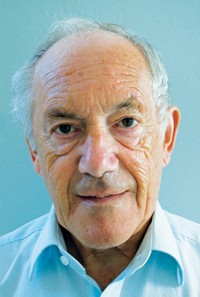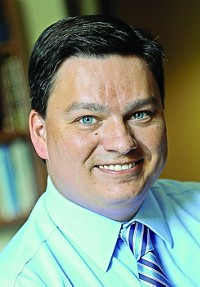Advertisement
Grab your lab coat. Let's get started
Welcome!
Welcome!
Create an account below to get 6 C&EN articles per month, receive newsletters and more - all free.
It seems this is your first time logging in online. Please enter the following information to continue.
As an ACS member you automatically get access to this site. All we need is few more details to create your reading experience.
Not you? Sign in with a different account.
Not you? Sign in with a different account.
ERROR 1
ERROR 1
ERROR 2
ERROR 2
ERROR 2
ERROR 2
ERROR 2
Password and Confirm password must match.
If you have an ACS member number, please enter it here so we can link this account to your membership. (optional)
ERROR 2
ACS values your privacy. By submitting your information, you are gaining access to C&EN and subscribing to our weekly newsletter. We use the information you provide to make your reading experience better, and we will never sell your data to third party members.
Synthesis
A New Take on Organic Chemistry
An accessible, affordable presentation of organic synthesis and its impact on the world is suitable for the coffee table
by Stu Borman
June 16, 2008
| A version of this story appeared in
Volume 86, Issue 24

Coffee table books on synthetic organic chemistry don't appear every day, and few in fact have ever been published at all. But take heart if chemical synthesis is one of your abiding interests or you would just like to learn more about it. A colorful, large-format book on the subject has just been written by synthetic chemist K. C. Nicolaou of Scripps Research Institute and the University of California, San Diego, and his former postdoc Tamsyn Montagnon, now a research fellow at the University of Crete.
"Molecules That Changed the World" presents the reader an appealing blend of history with organic chemistry, biology, and medicine. Written with the general public in mind and not simply the science-literate among us, the book's style and content are more accessible than is the case for most other books on synthetic organic chemistry that you're likely to encounter.
"You can give this as a present to your grandparents, I tell my students, or you can send it to your senator or even the President," Nicolaou tells C&EN. It explains science and medicine in an easy to understand "Scientific American style," he says.
Nicolaou says he hopes the book will “explain the impact of chemistry on society” and that it “could help change the image of chemistry for the better and inspire and excite young people into careers in chemistry, biology, and medicine. It conveys a message to young people that chemistry is a fascinating and influential science to follow as a career and profession.”
“Molecules That Changed the World” meets these goals. Beginning with the Big Bang, in which the building blocks of all molecules were first created, and proceeding through a range of key natural and nonnatural molecules constructed in laboratories by human ingenuity, the book tells the story of organic synthesis and its importance to society. It covers 30 or so key organic compounds and compound families, ranging from urea, glucose, aspirin, birth control agents, penicillin, prostaglandins, and Taxol to the small-molecule drugs and biologics that are the primary focus of the modern pharmaceutical and biotechnology industries.
Although these compounds “represent only a small sample of the world of biologically related molecules, they amply illustrate the importance of this field of science to humankind and the way in which the field has evolved,” writes Harvard University chemistry professor, synthetic organic chemist, and Nobel Laureate E. J. Corey in a foreword. In a second foreword, chemistry professor and Nobel Prize winner Ryoji Noyori of Nagoya University, Japan, writes that the book “will become a cornerstone of chemistry education.”
Nicolaou says the idea for the book arose from his often having been asked to give presentations about his research “to lawyers, businesspeople, and even movie stars, most of whom had no idea about chemistry. Telling them facts about chemistry would bore them to death, so I was forced to make colorful slides about Taxol, for example—where it came from, how it can cure cancer. I was encouraged by that and thought it would be wonderful” to share this kind of information more widely, he says.
Serious writing of the book began around 2002, Nicolaou says. He started with aspirin, penicillin, and Taxol, and he and his coauthor subsequently expanded the coverage to other important compounds that have been made synthetically. "It isn't like we had the whole picture in our minds at first, like the table of contents or what the pages would look like," Nicolaou says. "It evolved as we went along."Nevertheless, in my opinion, the chapters do work together as a cohesive package.
The book's design was inspired by a pharmacy book Nicolaou received as a gift from Panagiotis Gerolymatos, president and CEO of Gerolymatos Group, a health care and beauty products company in Athens. "It was designed by one of his people, Katerina Bakali," Nicolaou says." I wrote to ask if his designer could please help with our book too. She did a chapter on penicillin, and it was very artistic, so we modified that as a model for the design of the rest of the book."
The work is replete with photos of scientists dating from about the time their key discoveries were made. Those depicted include classical synthetic chemists such as Emil Fischer, Paul Ehrlich, and Sir Robert Robinson, and many synthetic chemists active today, including Corey, Nicolaou himself, and Samuel J. Danishefsky of Memorial Sloan-Kettering Cancer Center and Columbia University.
But the book also manages to include text and photos on a wide range of notable nonscientists who have influenced or been touched by the field of chemistry, including England's Queen Victoria; Microsoft cofounder Bill Gates and his wife, Melinda; English poet Samuel Taylor Coleridge; President Dwight D. Eisenhower; actress Marilyn Monroe; and even rock legend Jimi Hendrix.
Queen Victoria wore mauve clothing colored with the first aniline dye, mauveine, discovered by English chemist William Henry Perkin Sr. The foundation run by Bill and Melinda Gates is trying to eradicate malaria, in part by supporting the discovery of more effective and affordable drugs. Coleridge was addicted to laudanum, a form of opium. Eisenhower's D-Day invasion effort was supported by the provision of 3 million doses of the antibiotic penicillin. And barbiturates were associated with the untimely deaths of Monroe and Hendrix.
The volume is organized chronologically by date of a compound's first synthesis. It starts with Friedrich W'hler's 1828 synthesis of urea The first demonstration that organic compounds didn't necessarily have to be created within living organisms. A chapter on the 1904 synthesis of the fragrant compound terpineol includes a discussion of perfumes and scents. A segment on the 1929 synthesis of haemin provides entrée into a discussion of natural and synthetic dyes and the concept of aromaticity. A chapter on the 1952 synthesis of morphine includes a discussion of psychoactive substances and recreational drugs, like LSD and ecstasy. A part on steroids includes information on birth control pills.
More recent compounds (and related topics) that are covered include penicillin (antibiotics); prostaglandins (asthma therapy); vitamin B-12 (nutritional deficiency); avermectin (agrochemicals); cyclosporin, FK506, and rapamycin (immunosuppression); calicheamycin (enediyne antibiotics); resiniferatoxin (flavorants); and thiostrepton (veterinary medicines). The book ends with a chapter on the recent use of genetic engineering to produce biologic drugs such as human insulin and erythropoietin.
Another achievement covered in the book is the 1944 formal synthesis of quinine by Harvard University chemists Robert B. Woodward and William von Eggers Doering. The synthesis is called "formal" because it was based on final steps carried out earlier by another group. The quinine chapter also covers the 2001 completion of the total synthesis by Columbia University's Gilbert Stork, using modern synthetic methods. However, the book was published a little too early to include a 2008 addition to the quinine saga, in which chemists Robert M. Williams and Aaron C. Smith of Colorado State University, Fort Collins, completed the total synthesis using the original earlier steps upon which the 1944 formal synthesis had been based (C&EN, Feb. 4, page 8). Nicolaou says he would like to revise the book periodically to keep it up to date by including new developments like that.
The book is sprinkled with user-friendly descriptions of a range of synthetic techniques and chemical phenomena, such as carbocations, conformational analysis, radicals, Grignard reactions, aromaticity, protecting groups, Diels-Alder reactions, Sharpless asymmetric hydroxylation and epoxidation reactions, aldol reactions, olefin metathesis, and the Woodward-Hoffmann rules. When I needed to learn about Heck-type reactions for an article I was writing, the book provided one of the most useful and accessible overviews on the topic that I could have hoped for. Not every member of the general public is likely to be excited by such topics, but those with an interest in science and an interest in expanding their horizons may well be interested.
The work is less than straightforward in its treatment of some controversial topics. The Woodward-Hoffmann rules have been one subject of controversy, in that the late Harvard chemist Robert B. Woodward has historically been credited with having conceived them, but Corey recently claimed publicly that he had given Woodward the idea. This is particulary touchy territory for Nicolaou because he was a student of Corey's.

“Molecules That Changed the World” addresses this issue largely by side-stepping it. A sidebar on the rules gives one quote from Woodward about how he dreamed up the idea and a cryptic statement from Corey about how he suggested it, with no editorial comment whatsoever. A reader not already familiar with the issue is left to puzzle over the contradiction and would in fact have no idea that the matter has been a subject of dispute.
“We are not going to resolve any controversies in this book,” Nicolaou tells C&EN. “We do expect that we will receive letters from people, perhaps. But we did our very best to state the facts as they are, and it was an enormous task. So we ask the community to be merciful, in a way, because we did our best to minimize errors.”
The book could have been a little more gracious in the chapter on Taxol. Total syntheses of the anticancer agent were achieved by Nicolaou's group and that of Florida State University chemistry professor Robert A. Holton virtually simultaneously in 1994. However, the book states that, the first total synthesis of Taxol to be published was that emanating from the Nicolaou laboratories. What follows is a full-page analysis of the Nicolaou synthesis and a half-paragraph on the synthetic strategy of Holton's group, although figures on the two syntheses are more comparable in size.
With a list price of $55, "Molecules That Changed the World" is surprisingly reasonable for a book of its graphical quality. "I want this book in the hands of students," Nicolaou says. "So we pushed very hard to have it at a very good price." He notes that students have responded enthusiastically to the book in courses at Scripps. Even though that's Nicolaou's own institution, his claim sounds plausible, as the book provides a more compelling approach to the usually intimidating subject of organic chemistry than is generally available.
The book's relative affordability compared with chemistry textbooks may help make it more widely available in academic chemistry and biology departments, in college and university libraries, and in public libraries than would otherwise be the case. So don't be too surprised if you see it sometime soon on a coffee table near you.
Stu Borman covers organic chemistry, biochemistry, drug discovery, carbohydrate chemistry, and other areas for C&EN.




Join the conversation
Contact the reporter
Submit a Letter to the Editor for publication
Engage with us on Twitter